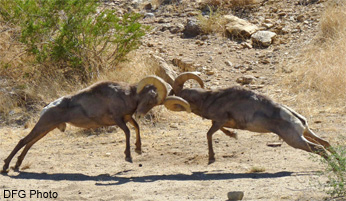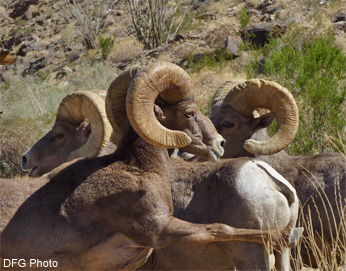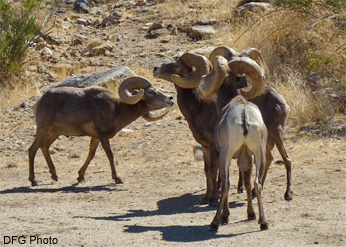Space-Use Patterns
Young bighorn sheep learn their habitat use patterns from older animals, and individuals may remain in the same
general area their entire lives. This philopatric behavior is more pronounced in females, who have smaller home
ranges than males. Size of the home range depends on the juxtaposition of resources (water, forage, and escape
terrain) and, therefore, varies geographically. In the Peninsular Ranges, average home range sizes of 25 and 20
square kilometers have been reported for males and females, respectively.
Desert bighorn sheep do not typically exhibit the seasonal migrations along elevational gradients that are observed
in northern populations. However, there are some seasonal differences in habitat use patterns, and home ranges are
often concentrated around water sources in the summer.
Activity Patterns
Bighorn sheep are primarily diurnal but may be active at any time of the day or night. Patterns of resting and
feeding are not synchronous within or between groups, and activity patterns may vary with age, sex, season, and habitat quality.
Behavior
Bighorn sheep are gregarious and their social structure is primarily matrilineal (based on female associations).
Females exhibit a high degree of philopatry and form “ewe groups”, made up of related females. Males move between
ewe groups during the breeding season.
Bighorn sheep have excellent vision, which is presumably important in predator evasion and social communication.
Body posture and scent play important roles in social communication. Bighorn sheep rarely vocalize, but do sometimes
bleat when seeking another animal (for example a female seeking her lamb), and they may make a coughing sound when alarmed.
The dominance hierarchy of bighorn sheep is important in determining an individual’s access to resources and mating
opportunities, and is based primarily on horn and body size.
Reproduction
Bighorn sheep are seasonal breeders and females typically produce one lamb per year. The mating season,
or “rut”, occurs from July through December. During this period, males compete for the opportunity to mate with females,
sometimes exhibiting fantastic head butting competitions. Lambs are born after a gestation period of approximately 6
months (171-185 days). In the Peninsular Ranges, most lambs are born January through June. Lamb survival can vary
greatly among groups and across years, with survival to 6 months of age reported to range from 0 to 80%. Survival of
lambs is likely influenced by rainfall (via its effect on plant productivity), and the presence of disease.
Photos
 Rams sparring during the rut.
Rams sparring during the rut.
 Ram Front Kick - Dominance behavior.
Ram Front Kick - Dominance behavior.
 Rams exhibiting low-stretch ritualized behavior.
Rams exhibiting low-stretch ritualized behavior.